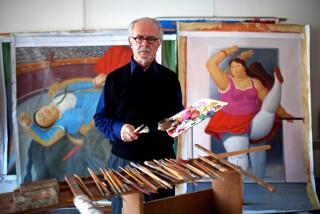‘Smoking Gun’ Tape Unveiled in Art Fraud Case
Prosecutors this week produced the “smoking gun” in their case against Anthony Gene Tetro, whom they describe as one of the nation’s most prolific art forgers: an audio tape in which a man identified as Tetro repeatedly refers to copying the works of other artists.
“I did a Chagall,” Tetro is heard to remark on the tape, played in Los Angeles Municipal Court. Later he answered “Yeah,” when asked if he had other fake Chagalls “in the works.”
For the record:
12:00 a.m. April 5, 1990 For the Record
Los Angeles Times Thursday April 5, 1990 Home Edition Metro Part B Page 3 Column 6 Metro Desk 1 inches; 32 words Type of Material: Correction
Pierre Marcand--A March 16 story identified Pierre Marcand as being named in an art fraud investigation. Marcand is a defendant in a civil suit filed by the Federal Trade Commission but has not been named in any criminal actions.
The tape was obtained by Mark Henry Sawicki, a former associate of Tetro who reportedly wore a concealed wire during a 1989 visit to Tetro’s Claremont condominium. Sawicki agreed to cooperate with authorities after he was charged with selling forged art himself last year.
In testimony before Judge Glenette Blackwell during a preliminary hearing into the 44-count felony forgery indictment returned against Tetro, Sawicki said he did $75,000 to $100,000 worth of business a year with Tetro between 1984 and 1989. Sawicki said he obtained and later sold hundreds of works attributed to artists such as Joan Miro, Salvador Dali and Hiro Yamagata.
Sawicki also testified that he observed Tetro copying those artists’ works and practicing the signatures of people ranging from Dali to Norman Rockwell. “He would practice on note pads, scratch paper, sometimes even on the backs of damaged artwork,” Sawicki said.
Tetro, with his shoulder-length hair and designer glasses, was impassive during his former associate’s testimony. But his attorney, George W. Porter, questioned Sawicki’s credibility, insinuating that he hoped to earn “Brownie points” by cooperating with the law. Sawicki, who pleaded guilty last year to 10 forgery and grand theft counts, said he was not promised anything.
Sawicki and Tetro are just two of the dealers implicated by local and federal authorities in a multimillion-dollar art fraud investigation. Also named are Beverly Hills art dealer Pierre Marcand, accused of creating and selling 22,000 fraudulent prints; art broker Frank De Marigny, charged with two counts of grand theft and five counts of forgery, and Lee Sonnier, former manager of the Upstairs Gallery in Beverly Hills, also facing grand theft charges.
Authorities have refused to say if there is a connection between the suspects. But federal officials have described Southern California, with its affluent populace and heavy tourist trade, as an international hub for the sale of all kinds of fraudulent artworks.
Sawicki’s allegations are among the most damaging yet to emerge in the case because he allegedly had direct dealings with Tetro, 40, described as a major target of the investigation.
In his testimony Wednesday and Thursday, Sawicki told of seeking out Tetro as an alleged source of phony art. He also said that Tetro’s reputation was well known in some art circles.
“I heard he was associated with forgeries,” said Sawicki, who added that many of the artworks he obtained from Tetro were later sold to private collectors and other galleries.
Sawicki, former owner of a Sherman Oaks art gallery called Visual Environments, told Deputy Dist. Atty. Reva Goetz that his final meeting with Tetro occurred last April, after Sawicki’s arrest. Sawicki, who owed Tetro $20,000 for artworks he had taken on consignment, was wearing a concealed taping device when they met at Tetro’s condominium.
Tetro’s attorney did not contest in court that the voice heard on the tape was that of his client.
In the course of their taped conversation, a nervous-sounding Sawicki asked if Tetro had sent his “bone crusher” after him for the money he owed. Tetro replied, “Yeah.”
The two spent more than 20 minutes discussing various works of art and mutual friends before Sawicki left, having been assured that the “bone crusher” had been called off.
“This is a happy experience for me, I’m telling you,” Tetro said in the taped conversation after Sawicki paid him $8,000 and returned the remaining artworks he had taken.
Sawicki later testified that watercolors attributed to the artist Yamagata, whose paintings and lithographs have become extremely popular in recent years, were among the forged works he obtained from Tetro. In earlier testimony, Yamagata confirmed that about 29 watercolors bearing his signature and seized in the case were fakes. Speaking through an interpreter, the Japanese-born artist said he had never even seen the watercolors.
“I never painted this image,” Yamagata said time and again as he was shown the works.
Under cross-examination by Porter, Yamagata grudgingly revealed that he was paid about $1,000 apiece for artworks that later fetched $5,000 to $10,000 on the open market, prompting Judge Blackwell to proclaim, “Get yourself a new agent,” in an off-the-record comment.
Yamagata also engaged in repeated clashes with Porter, accusing him in rapid-fire Japanese of trying to trick him into revealing the secrets of his creative process.
“I can’t teach you how to paint in this court,” Yamagata said at one point.
Testimony in Tetro’s preliminary hearing is to resume on Monday.
More to Read
The biggest entertainment stories
Get our big stories about Hollywood, film, television, music, arts, culture and more right in your inbox as soon as they publish.
You may occasionally receive promotional content from the Los Angeles Times.










